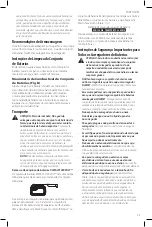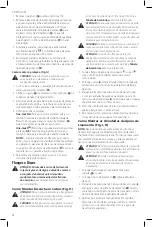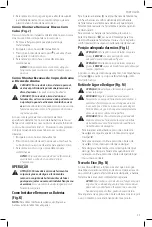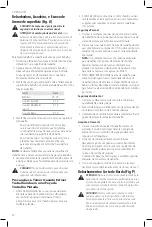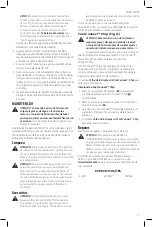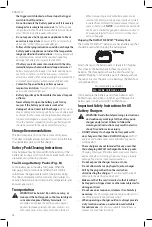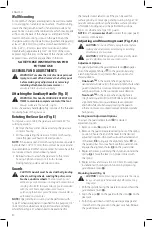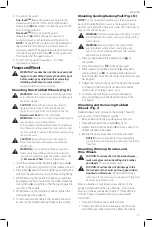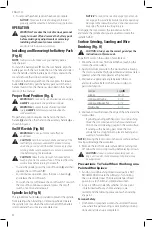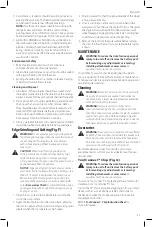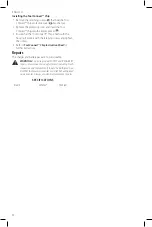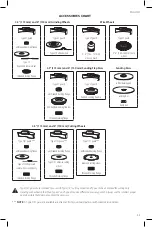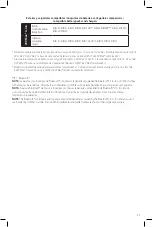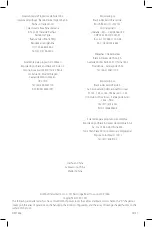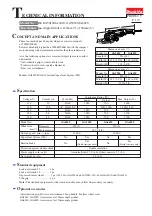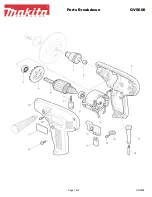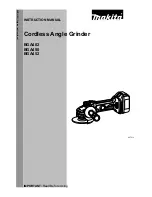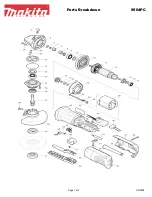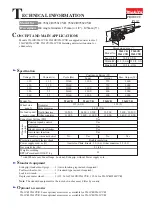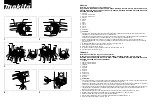
39
ENGlIsh
charger or removed. Some chargers require the battery
pack release button to be pressed for removal.
4. Charger will not charge a faulty battery pack, which
may be indicated by the light staying OFF. Take charger
and battery pack to an authorized service center if light
stays OFF.
NOTE:
Refer to label near charging light on charger
for blink patterns. Older chargers may have additional
information and/or may not have a yellow indicator light.
hot/Cold pack Delay
When the charger detects a battery pack that is too hot
or too cold, it automatically starts a Hot/Cold Pack Delay,
suspending charging until the battery pack has reached an
appropriate temperature. The charger then automatically
switches to the pack charging mode. This feature ensures
maximum battery pack life.
A cold battery pack may charge at a slower rate than a warm
battery pack.
The hot/cold pack delay will be indicated by the red light
continuing to blink but with the yellow light continuously
ON. Once the battery pack has reached an appropriate
temperature, the yellow light will turn OFF and the charger
will resume the charging procedure.
DCB118 and DCB1112 Chargers
The DCB118 and DCB1112 chargers are equipped with
an internal fan designed to cool the battery pack. The fan
will turn on automatically when the battery pack needs to
be cooled.
Electronic Protection System
Li‑Ion tools are designed with an Electronic Protection
System that will protect the battery pack against overloading,
overheating or deep discharge. The tool will automatically
turn off and the battery pack will need to be recharged.
Important Charging Notes
1. The charger and battery pack may become warm to the
touch while charging. This is a normal condition, and
does not indicate a problem. To facilitate the cooling of
the battery pack after use, avoid placing the charger or
battery pack in a warm environment such as in a metal
shed or an uninsulated trailer.
2. If the battery pack does not charge properly:
a. Check operation of receptacle by plugging in a lamp
or other appliance;
b. Check to see if receptacle is connected to a light
switch which turns power off when you turn out
the lights;
c. If charging problems persist, take the tool, battery
pack and charger to your local service center.
3. You may charge a partially used pack whenever you
desire with no adverse effect on the battery pack.
Charger Cleaning Instructions
WARNING:
Shock hazard. Disconnect the charger
from the AC outlet before cleaning. Dirt and grease
may be removed from the exterior of the charger using
a cloth or soft non-metallic brush. Do not use water or
any cleaning solutions.
•
An extension cord must have adequate wire size for
safety.
The smaller the gauge number of the wire, the
greater the capacity of the cable, that is, 16 gauge has
more capacity than 18 gauge. An undersized cord will
cause a drop in line voltage resulting in loss of power and
overheating. When using more than one extension to
make up the total length, be sure each individual extension
contains at least the minimum wire size. The following
table shows the correct size to use depending on cord
length and nameplate ampere rating. If in doubt, use the
next heavier gauge. The lower the gauge number, the
heavier the cord.
Voltage
(Volts)
Total length of cord in meters (m)
120–127V
0–7
7–15
15–30
30–50
220–240V
0–15
15–30
30–60
60–100
Rated
ampere
Range
Minimal cross‑sectional area of the
cord in meters (mm
2
)
0–6A
1,0
1,5
1,5
2,5
6–10A
1,0
1,5
2,5
4,0
10–12A
1,5
1,5
2,5
4,0
12–16A
2,5
4,0
Not Recommended
•
Do not place any object on top of the charger or place
the charger on a soft surface that might block the
ventilation slots and result in excessive internal heat.
Place the charger in a position away from any heat source.
The charger is ventilated through slots in the top and the
bottom of the housing.
•
Do not operate the charger with a damaged cord
or plug.
Have them replaced immediately.
•
Do not operate the charger if it has received a sharp
blow, been dropped or otherwise damaged in any
way.
Take it to an authorized service center.
•
Do not disassemble the charger; take it to an
authorized service center when service or repair
is required.
Incorrect reassembly may result in a risk of
electric shock, electrocution or fire.
•
The charger is designed to operate on standard
120V–127 (low voltage) or 220V–240V (high voltage)
household electrical power. Do not attempt to use
it on any other voltage.
This does not apply to the
vehicular charger.
•
Foreign materials of a conductive nature, such as, but
not limited to, grinding dust, metal chips, steel wool,
aluminum foil or any buildup of metallic particles
should be kept away from the charger cavities and
ventilation slots.
•
Always unplug the charger from the power supply
when there is no battery pack in the cavity.
Charging a Battery (Fig. C)
1. Plug the charger into an appropriate outlet.
2. Insert and fully seat battery pack. Red charging light will
continuously blink while charging.
3. Charging is complete when the red charging light
remains continuously ON. Battery pack can be left in

